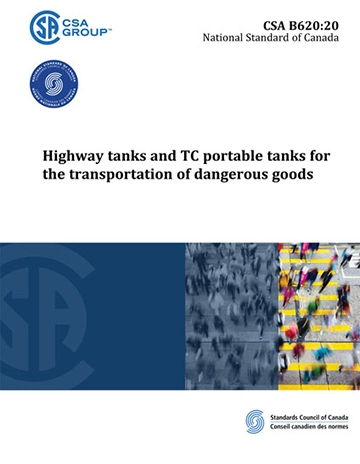The CSA B620:20 Standard and Redline bundle is also available for purchase. This bundle includes a copy of the active standard and the redline version in digital format. The redline document is designed to highlight changes from one edition to the next. Buy Now!
Preface
This is the sixth edition of CSA B620, Highway tanks and TC portable tanks for the transportation of dangerous goods. It supersedes the previous editions published in 2014, 2009, 2003, 1998, and 1987.
This Standard specifies requirements for highway tanks, portable tanks, fibre-reinforced plastic (FRP) highway tanks, and pressure/vacuum liquid waste highway tanks for the transportation of dangerous goods. It also specifies requirements for hose assemblies used to load or unload dangerous goods.
The major changes to this edition include the following:
• updated American Society of Mechanical Engineers (ASME) code references;
• new training organization registration for qualification of tank inspectors and tank testers;
• updated tank inspector and tester training and qualification requirements;
• revised tank securement requirements for all highway tanks;
• revised damage protection requirements for TC 331, TC 338, and TC 341 tanks;
• 10 year internal inspection and pressure test frequency permitted for certain, smaller tanks in dedicated propane service with maximum capacity of 13250 L, used to transport UN1978 (propane);
• new pressure gauge selection and calibration requirements for pressure tests;
• revised thickness testing requirements;
• revised pressure testing requirements;
• revised inspection and test reporting requirements;
• reintroduction of TC 51 portable tanks, with updated requirements; and
• revised insulation requirements for TC 423 tanks.
It is the intent of the CSA Technical Committee to further develop this Standard in co-operation with industry representation and regulatory authorities in Canada and the United States to meet the needs of Canada and to achieve a maximum degree of uniformity with the United States.
This Standard is one of a series of Standards that have been prepared for use in conjunction with the Transportation of Dangerous Goods Regulations. It should be noted that this Standard, by itself, does not have the force of law unless it is officially adopted by a regulatory authority. Since the Standard may be adopted into regulations with certain exceptions or additional requirements, it is recommended that the regulations of the relevant jurisdiction be consulted in order to establish the extent to which this Standard has been adopted. Where an industry practice differs from the requirements of this Standard, an application for a permit for equivalent level of safety may be requested from the regulatory authority.
This Standard has been developed in compliance with Standards Council of Canada requirements for National Standards of Canada. It has been published as a National Standard of Canada by CSA Group.
Scope
1.1
This Standard applies to tanks, other than intermediate bulk containers and tubes, used for the transportation of dangerous goods primarily by road. It considers the design, construction, certification, assembly, modification, repair, testing, inspection and periodic retesting, maintenance, and identification of such tanks. This Standard also applies to the hose assemblies used to load or unload dangerous goods.
Additional design and construction requirements for tanks intended to carry specific products are provided in CSA B621, CSA B622, CSA B626, and CAN/CGSB-43.151.
1.2
The Transportation of Dangerous Goods (TDG) Act and the Transportation of Dangerous Goods Regulations can set out requirements that are additional to or different from those in this Standard due to particular characteristics or properties of individual dangerous goods. Where there is an inconsistency between the requirements of this Standard and those of the Act or Regulations, the Act or Regulations prevail to the extent of the inconsistency. Where there is an inconsistency between this Standard and a referenced publication other than the TDG Act or Regulations, the requirements of this Standard prevail. Application of a referenced publication should be made only with careful consideration of this Standard’s reference to that particular publication.
1.3
The use of this Standard does not reduce the necessity for competent engineering judgment or complete design calculations that take into account the intended use of the tank. The values of the various parameters in this Standard are the limiting values to which the tank is restricted. It is the responsibility of the tank manufacturer to ensure that the tank will safely carry out its intended function within these constraints.
1.4
In this Standard, shall is used to express a requirement, i.e., a provision that the user is obliged to satisfy in order to comply with the standard; should is used to express a recommendation or that which is advised but not required; may is used to express an option or that which is permissible within the limits of the standard; and can is used to express possibility or capability.
Notes accompanying clauses do not include requirements or alternative requirements; the purpose of a note accompanying a clause is to separate from the text explanatory or informative material.
Notes to tables and figures are considered part of the table or figure and may be written as requirements.
Annexes are designated normative (mandatory) or informative (non-mandatory) to define their application.
1.5
The values given in SI (metric) units are the standard. The values given in parentheses are for information only. Units for pressure refer to gauge pressure unless otherwise noted.

